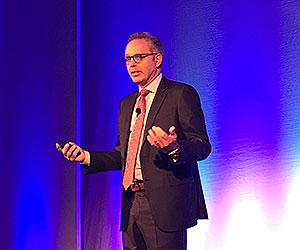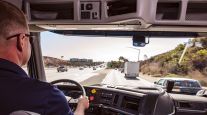Lytx Debuts Tiered Platform for Safety, Fleet Services

SAN DIEGO — Lytx is rolling out an updated suite of video safety and telematics services that company executives said is a response to the evolving expectations of fleet users.
“Three or four years ago, we started to see that in the industry that video was becoming more accepted,” Lytx CEO Brandon Nixon said in an exclusive interview with Transport Topics from the company’s seventh annual User Group Conference here. “It was no longer a battle of video versus no video. What we found was that, if companies were not doing video, then they’re being irresponsible to their shareholders, their communities and their drivers. But it is also the case that a video solution is not homogeneous across all companies.”

Brandon Nixon addresses the user group conference. (Joe Howard/Transport Topics)
To expand fleets’ flexibility for tailoring those products to their needs, Lytx in February introduced a product platform built on a tiered approach that allows customers to select among video, risk management and fleet management offerings. “It allows companies to come in a variety of different ways, and engage with the platform, and then they can expand or reduce it over time,” Nixon said.
On the first level is what the company calls Lytx Video Platform, which replaces Lytx Video Services. The new package provides over-the-air access to approximately 100 hours of continually recorded video from the DriveCam event recorder and allows fleets to access video anywhere from a few minutes to weeks in the past. The data can help exonerate drivers in accident claims, and help fleets confirm service deliveries or conduct virtual ride-alongs, Lytx said. Video also can be livestreamed from a desktop or mobile device, Lytx said. The service can be used stand-alone but is required to enable the other service tiers.
More From the Conference
Also, the name DriveCam will now refer only to the Lytx event recording device itself, since this is what many clients already call the unit, Nixon said. “Everybody uses it that way,” he said. “They’d point at the device and call it the DriveCam, so we just sort of went with what the market is doing already.” Previously, DriveCam referred to the company’s entire product suite.
Under the new system, the newly named Driver Safety Program tie will include all of the previous DriveCam features, such as coaching workflow and program management, while adding continual recording technology and improved functionality and configurability, Lytx said.
The company also is introducing a Risk Detection Service package that provides the ability to monitor risky driving behavior through access to video clips of specific events as well as incident notifications, along with video support of events as they happen, Lytx said. The company is retiring the ActiveVision product, its initial machine vision and artificial intelligence interface launched in 2016 to combat distracted and drowsy driving. These two offerings will now be included in the risk-detection package. “We are embedding it into everything we do,” Nixon said. “It is no longer an option you layer on top.”
With a subscription to the video platform, customers can elect to add the risk-detection package, one or two driver safety tiers, or all three, Nixon added.
The effort to revamp the product portfolio evolved over time and was a response to customer inputs, noted Michael Phillippi, Lytx vice president of technology.
“We didn’t sit in a room and invent it; we just sat and listened to our customers talk to us about what challenges they have,” he said. “Whether that was a large fleet that said, ‘I don’t manage risks the same with my owner-operators as my employees,’ or they said, ‘I have different classes of vehicles, and I don’t want to treat them all the same.’ ”
Plus, having the base video platform provides carriers with access to crash footage to protect themselves and their drivers during potential investigations. “Some customers have said, ‘Hey, I’m not ready to do the whole safety program, but I sure don’t want to miss the collision,’ ” he said. “Whether it was responding to a larger customer who has diverse needs, or the market itself being diverse, that’s what the product portfolio came from.”



